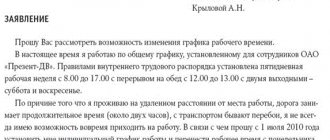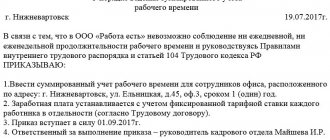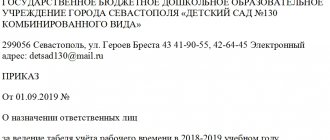The maximum permissible working hours during the day and week are established by law, in particular, by the Labor Code (Article 91 of the Labor Code of the Russian Federation).
Dear readers! The article talks about typical ways to resolve legal issues, but each case is individual. If you want to find out how to solve your particular problem , contact a consultant:
+7 (499) 110-56-12 (Moscow)
+7 (812) 317-50-97 (Saint Petersburg)
8 (800) 222-69-48 (Regions)
APPLICATIONS AND CALLS ARE ACCEPTED 24/7 and 7 days a week.
It's fast and FREE !
But exactly what time employees start work, finish it, go on a break, that is, what the working hours will be, each employer decides independently. It is based on the needs of the organization.
If the regime is the same for all employees, then it is enshrined in the Internal Labor Regulations (ILR). And every employee entering work is familiarized with this document upon signature.
If the work procedure is different for some employees, this is stated in their employment contracts.
For example, in an organization the working day starts at 8:30 and lasts until 17:30. It includes an hour and a half break from 12 to 13-30. This is indicated in the corresponding paragraph of the PVTR. However, system administrator Ivanov works from 10 to 20 o’clock and has lunch from 3 to 5 o’clock in the afternoon. This is agreed upon in advance and written down in his contract with the employer. He is not obliged to comply with this point of the schedule and arrive at 8-00.
In what cases is a document required?
The law does not prohibit an employer from changing working hours. As a rule, the basis for such a decision is the peculiarities of business processes.
The reform can affect the entire organization as a whole, as well as individual divisions or even employees. But such a change must be properly formalized. In addition, the changes introduced should not lead to a deterioration in working conditions and the situation of workers.
A change in working hours is entered by a local document - an order. But its content and approval procedure depend on where exactly the current working time regime was recorded.
There can be three options:
- the regime is the same for everyone and is prescribed only in the PVTR;
- the regime is the same for everyone and is prescribed in the PVTR and the employment contract;
- The regime is individual and is included only in the employment contract.
The rules of procedure have a special approval procedure. It is described in Art. 190 TK. Workers, through their representatives (trade union), participate in the discussion of its conditions.
The document agreed upon with them is approved by order. Any changes to the PVTR are also formalized. If the Rules serve as an annex to the collective agreement, then their changes are subject to the rule of Art. 44 TK.
Labor Code of the Russian Federation
Another option for changing working hours is the will of the employer. But not in any case, but only if this is due to the reasons set out in Art. 74 TK.
Changes in working conditions must be justified by objective changes in the work process, technological, organizational, or a combination thereof. This should also be reflected in the order.
Changes to the employment contract, including those relating to working hours, are made by agreement of both parties (Article 72 of the Labor Code).
The agreement reached must be recorded in writing in the form of an additional agreement. Otherwise, such innovations are illegal and the employee has the right to seek protection of his rights through the labor inspectorate or the court.
About the work schedule
There are several types of work schedules that are allowed to be used at an enterprise in accordance with the Labor Code of the Russian Federation. This information is specified in Art. 100 Labor Code of the Russian Federation. The norms specified in the law also apply to the length of the week. Workers can carry out their activities for 5 days, 6 days, or according to other rules. The law also specifies that days off are provided on a staggered schedule. Sometimes it only lasts for less than a week.
An irregular schedule is discussed in This type is a special mode of activity when employees are involved in work during certain periods, regardless of what the main schedule is. It is not used in every institution. Art. 102 of the Labor Code of the Russian Federation includes conditions for a flexible schedule - work is carried out in shifts, days, their duration is established based on an agreement between the parties.
The shift schedule is indicated in Art. 103 Labor Code of the Russian Federation. This mode is needed when the production process does not fit within working hours. For example, when blast furnaces cannot be turned off or production processes cannot be stopped. Accounting for the worked period is carried out according to Art. 104 Labor Code of the Russian Federation. For example, the working week should be no more than 40 hours.
If it concerns workers who work in hazardous work, then accounting is carried out every 3 months. In Art. 105 of the Labor Code of the Russian Federation indicates dividing a work shift into parts, but only if this does not cause a disruption in the production process. The completed schedule must be agreed upon with the trade unions and displayed in the documentation.
Who makes the decision?
The decision on all changes, including working hours, is made by the manager. This is within his competence.
But there are two important points here.
If we are talking about introducing new conditions into an employment contract, then a written agreement with the employee is required (Article 72 of the Labor Code). Well, the procedure for adopting the PVTR, according to Art. 190 of the Labor Code, requires agreement on new working hours with the trade union or other employee representatives.
A sole decision of the manager made in violation of these requirements will become a reason for a labor dispute.
What is part-time work? Is consent required for employment by transfer? See here.
Rules for issuing an order to change working hours
An order to change working hours, like any administrative document, must have the following required details:
- Name of the organization;
- document type;
- date of compilation;
- serial number;
- title;
- main text;
- manager's signature;
- necessary approvals.
Main sections
As for the content of the order, it consists of several important blocks:
- justification for the changes introduced (agreement with the employee or change in working conditions);
- abolition of the old regime;
- a complete description of the new working hours;
- the date of its introduction;
- instructions to warn workers in advance about changes in their working conditions.
Document form
Like any important document, an order to change working hours is drawn up in writing.
Its original, signed by the manager, is kept in the general department or in the employee’s personal file (if we are talking about changing the terms of the employment contract).
Documents issued on its basis will also be written: notifications and additional agreements.
Sample order (drawing example)
Here is a sample order to change the working hours for the entire organization:
If we are talking about changing the working hours for a specific employee, then it is necessary to draw up an order and conclude a written agreement on the changes made to the employment contract.
Order:
The main text of such a document will be as follows: » the working hours are established from 09-00 to 17-30 with a break from 12-30 to 13-00 lasting 30 (thirty) minutes.
Example of an additional agreement:
Irregular working hours - how many hours? Read our article. What costs are attributed to lost working time? Find out here.
You will find the rules for issuing a duplicate work book here.
Basic concepts and sample order
The working hours of employees should be regulated only by special orders.
The working hours themselves are initially set when a candidate is first hired for a particular position.
He must be informed at what time he can rest, and at what time he must report to his place. This is a mandatory clause of the employment contract that requires the signature of the other party.
The work schedule is described in one of these documents:
- Internal regulations.
- A contract of a collective nature, or an ordinary labor contract.
Future employees put their signature under each of these documents
. This means that they agree with the working conditions and are happy with everything. You cannot unilaterally change something and then only report the changes after the fact.
You can download a sample order to change the operating mode.
Orders to change the working regime must include all employees for whom the new rule is being introduced.
The paper strictly states when the work begins and when it ends.
Important nuances
It is not enough to correctly draw up and sign an order to change working hours. There are a number of legal requirements that must be met. Namely, employees need to be notified of upcoming changes. And this must be done no later than two months before the introduction of the new regime (Article 74 of the Labor Code).
That is, if the order says that changes are introduced from December 1, then the order is signed not on November 30, but at least on October 1, and preferably even earlier. Then, on its basis, additional agreements are drawn up with employees.
Example notification:
How to introduce employees?
Employees must be familiarized with the changes being introduced by signature. But it is not placed on the order, but on the individual written notification that each of them receives.
This document specifies the reason for the changes, the deadline for their introduction and information about the consequences of the employee’s refusal to work in this mode (termination of the employment contract under clause 7, part 1, article 77 of the Labor Code).
The employee either receives the notice in hand or refuses to do so. In this case, an act is drawn up. In this case, the notification is read out orally.
A notice may also be sent to a refused or absent employee by mail to the address specified in the employment contract. In this case, the employer is considered to have fulfilled his obligation to promptly warn his subordinates.
Work schedule as a document regulating daily individual work schedule
The work schedule is one of the most important documents for organizing the work of those employees who do not work according to the general (production) calendar. Thus, the daily schedule regulates the time of coming to work, leaving work, break times, and even the workplace assigned to the employee.
The schedule is usually drawn up for one month,
but this period is not regulated by law.
Therefore, depending on the circumstances and characteristics of the production process, the document can be drawn up for a week, a quarter, or a year.
The schedule, as a document, can be drawn up:
- simultaneously for all employees of the enterprise;
- for employees of one structural unit;
- for a certain group of employees from different structural divisions;
- separately for one employee.
Form and symbols
In the shift schedule it is enough to indicate only the shift designation
When summarizing accounting, the schedule must contain columns reflecting the amount of hours per month, per quarter (depending on the accounting period)
The process of drawing up and approving the schedule
The procedure for drawing up and approving a schedule in an organization can be regulated either by a local regulatory legal act or by order of the manager. Persons responsible for maintaining, approving and approving documents are determined by designation in these documents and the inclusion of a corresponding item in the job description.
As a rule, the schedule is drawn up by the person responsible for this in the structural unit (department, service), endorsed by the head of the structural unit, a representative of the personnel department and the trade union, approved by the head of the enterprise or his deputy in charge of the relevant area of activity.
The schedule can be drawn up either manually (using standard Office tools with output on paper) or in specialized software packages (for example, 1C: HR and Salary, SAP, etc.).
Schedule requirements
When drawing up a work schedule, the employer is in a situation where it is necessary to comply with a lot of rules, requirements and interests. First of all, these are the requirements of labor legislation that protects the rights, interests and even health of the employee:
- The duration of daily work should not exceed those established by Art. 94 of the Labor Code of the Russian Federation limits (special limits are established for minor employees, disabled people, workers in harmful unsafe conditions).
- The number of working hours per week should not exceed the norm according to the production calendar (40 hours as a general rule). For those who have been assigned summarized accounting for an accounting period, it is mandatory to comply with the standard hours for this accounting period (quarter, month, etc.).
- Shifts that primarily occur at night should be reduced by 1 hour.
- After a shift lasting more than 24 hours, an equal or greater rest period is provided.
- If the employee does not have a condition for dividing the working day into parts, his lunch break (or the sum of several during the day) should not last more than two hours.
- The minimum lunch break is 30 minutes. It is obligatory to establish daily, if the agreement of the parties and the PVTR does not provide for the employee to eat food in parallel with work. Lunch break is not paid.
- It is prohibited to work during two shifts following one another.
- Hours that fall during an employee's illness or vacation are also included in his monthly (quarterly) rate. In other words, the employee is not required to make up the hours actually missed to normal.
- The limits established by Art. 99 of the Labor Code of the Russian Federation for overtime work (no more than four hours in a two-day working period, no more than one hundred and twenty hours per year), etc.
Of course, when creating a schedule, the operating mode of the enterprise, workload standards, and the interests of the employee himself are taken into account.
Employee familiarization
The employer is obliged to familiarize employees with the work schedule no later than one month before the day it comes into effect - this is a direct requirement of Art. 103 Labor Code of the Russian Federation. Violation of this deadline may result in administrative liability.
To avoid violating the requirements of the law, you should start drawing up a schedule no later than one and a half months before the start of the accounting period. For example, the schedule for December should be drawn up before October 15 in order to have time to coordinate, approve and familiarize all employees with it (after all, some of them at the time of familiarization may be on vacation or on sick leave, but this circumstance is not an excuse in case of violation of the deadlines for familiarization ).









